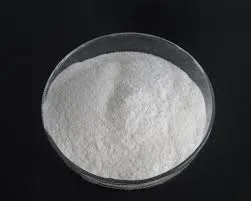
سبتمبر . 26, 2024 06:22 Back to list
cellulose ether hpmc
Understanding Hydroxypropyl Methylcellulose (HPMC) Characteristics, Applications, and Benefits
Hydroxypropyl Methylcellulose (HPMC) is a cellulose ether composed of methoxy and hydroxypropyl substituents on the cellulose backbone. This versatile polymer is synthesized from cellulose, a natural polymer primarily derived from plant sources. Due to its distinctive chemical properties, HPMC has gained immense popularity in various industries, including pharmaceuticals, construction, food, and cosmetics.
Properties of HPMC
One of the notable characteristics of HPMC is its excellent solubility in water. Depending on the degree of substitution and the molecular weight, HPMC can function as a thickening agent, film-forming agent, or emulsifier. In aqueous solutions, HPMC can form viscous gels, making it useful in formulations where viscosity control is crucial. Additionally, HPMC is thermally stable and can withstand a variety of pH levels, allowing it to be employed in numerous applications where other materials may fail.
Another significant property of HPMC is its ability to create transparent films. This feature is particularly advantageous in cosmetic formulations, where a smooth texture and consistency are essential. Furthermore, HPMC is non-toxic and biodegradable, making it a preferred choice in formulations committed to environmental sustainability.
Applications of HPMC
1. Pharmaceuticals In the pharmaceutical industry, HPMC is widely used as a binder in tablet formulations and as a controlled-release agent. Its gel-forming properties facilitate the sustained release of active ingredients, thereby enhancing bioavailability. Moreover, HPMC is used in preparing suspensions and emulsions, where its thickening ability ensures even distribution of the active substances.
2. Construction HPMC is extensively utilized in the construction sector as an additive in mortar, plaster, and tile adhesives. In these applications, HPMC improves workability, enhances water retention, and increases adhesion properties. The increased flexibility and durability of construction materials containing HPMC contribute to longer-lasting structures and reduced repair needs.
cellulose ether hpmc

3. Food Industry In the food industry, HPMC serves as a food additive where it acts as a thickener, stabilizer, and emulsifier. Its ability to retain moisture is particularly beneficial in baked goods, ensuring freshness and extended shelf life. Additionally, HPMC is often used in gluten-free products, providing texture and binding capabilities that replicate those of traditional wheat-based items.
4. Cosmetics The cosmetic industry benefits from HPMC's film-forming and thickening properties. It is found in a range of formulations, from lotions and creams to hair products, where it enhances texture and stability. HPMC's non-irritating nature makes it suitable for sensitive skin formulations, contributing to its widespread use in skincare products.
Benefits of HPMC
The benefits of HPMC extend beyond its functional properties. One of the primary advantages is its versatility, allowing it to be used across multiple industries. Manufacturers favor HPMC due to its cost-effectiveness and its ability to enhance product performance without compromising safety.
Furthermore, HPMC opens the door for innovative formulations. In combination with other polymers, HPMC can create hybrid materials with tailored properties, meeting specific requirements in diverse applications. Its environmentally friendly profile also appeals to industries moving toward sustainable practices, assuring consumers of the safety and biodegradability of products containing HPMC.
Conclusion
In summary, Hydroxypropyl Methylcellulose (HPMC) is a multifaceted cellulose ether with a broad range of applications. Its unique properties, including solubility, film-forming ability, and non-toxic nature, make it an invaluable ingredient in pharmaceuticals, construction, food, and cosmetics. As industries seek sustainable and efficient solutions, HPMC stands out as a reliable choice, highlighting the continued importance of cellulose-derived materials in modern manufacturing and formulation processes. The future relies on innovations that harness the power of HPMC, promising advancements across various sectors.
-
The Widespread Application of Redispersible Powder in Construction and Building Materials
NewsMay.16,2025
-
The Widespread Application of Hpmc in the Detergent Industry
NewsMay.16,2025
-
The Main Applications of Hydroxyethyl Cellulose in Paints and Coatings
NewsMay.16,2025
-
Mortar Bonding Agent: the Key to Enhancing the Adhesion Between New and Old Mortar Layers and Between Mortar and Different Substrates
NewsMay.16,2025
-
HPMC: Application as a thickener and excipient
NewsMay.16,2025
-
Hec Cellulose Cellulose: Multi functional dispersants and high-efficiency thickeners
NewsMay.16,2025







